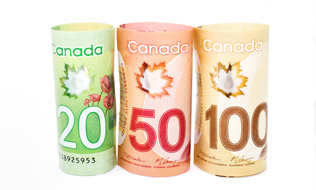

Despite the weak Canadian dollar, the top 40 Canadian money managers increased their pension assets by 3.2 per cent in 2015, according to Benefits Canada’s 2016 money managers report.
“Most of that is market appreciation,” says Mark Cestnik, managing director at TD Asset Management in Toronto, adding that, last year, Canadian universe bonds generated a 3.5 per cent return, global equities brought a 19 per cent return, and Canadian equities declined by 11 per cent.
For a simple portfolio invested half into bonds, 25 per cent into global equities and 25 per cent into Canadian equities, “if you total it all up, they got around 3.75 per cent. So it’s not too far off,” says Cestnik.
Read: Top 40 Money Managers: Why pension funds are turning to non-core infrastructure
The weak dollar also acted “as a useful nudge for revisiting [pension plans’] policy decisions,” says Peter Muldowney, senior vice-president, institutional strategy at Connor Clark & Lunn Financial Group in Toronto. While it didn’t encourage pension plans to buy or sell certain assets, as money managers tend to pick and stick with strong companies rather than predict economic cycles, companies do re-examine whether their overall risk appetites are still working.
Long-term investors such as pensions, Muldowney points out, often don’t consider “shorter-term noise . . . at a strategic level. Otherwise, you’d be reacting to every little nuance.”
For example, pensions that left their foreign investments unhedged did well as the loonie tumbled, he says. Those gains “acted as a catalyst for those pension investors to take a look back and revisit their policy with respect to currency hedging. While they benefitted from being unhedged, they just wanted to make sure they were comfortable with their currency management position.”
Low interest rates also forced some pension plans to increase their risk appetite and invest in more illiquid assets. In the past 2.5 years, Cestnik says, institutional investors have been getting just “coupon-like returns” of two to three per cent on their traditional bond investments.
Read: Institutional investors to embrace active management in 2016
So Cestnik has seen many new clients move into “core-plus” investments, which include private debt and other products with more risk and potentially more return. Pension plans are “coming to realize now, more recently, that they don’t need as much liquidity as they previously believed,” he says. “And therefore, they can think about potentially making an allocation of five or 10 per cent of their fixed-income bucket into things that are more illiquid.”
TD Asset Management’s growth in Canadian pension assets under management of 10.4 per cent in 2015 was due in large part to new core-plus business, says Cestnik.
Sun Life Institutional Investments (Canada) Inc. has also noticed that “the traditional asset allocation between fixed income and equity is changing with people looking for uncorrelated returns,” says president Carl Bang in Toronto. “And this gives rise to another asset class, which is typically deemed alternative asset classes, which might not necessarily move to the same degree as equities or in a different direction to equities.”
Sun Life’s Canadian pension assets grew by a whopping 22,537 per cent last year, which Bang attributes to a surge of new clients. The funds were launched in 2014 and, by the end of the year, had $7.6 million in pension assets. In 2015, “growth continued accelerating” to a total of $1.7 billion.
Read: Why Canadian investors are stuck in their own Groundhog Day
Global Alpha Capital Management Ltd. — a Connor Clark & Lunn company whose mandate is in the area of global small market capitalization — saw a 93.2 per cent growth rate in 2015. Muldowney attributes the change to a rapidly growing interest in global small caps that provide a good counterbalance to Canadian small caps. Energy represents roughly 18.5 per cent of the Canadian small-cap index, while it’s three per cent for global small caps. Information technology is 3.2 per cent in the Canadian index and 13 per cent globally.
“It’s a different opportunity set and it’s also playing to this global theme,” he adds.
Download a PDF of the 2016 Top 40 Money Managers Report
